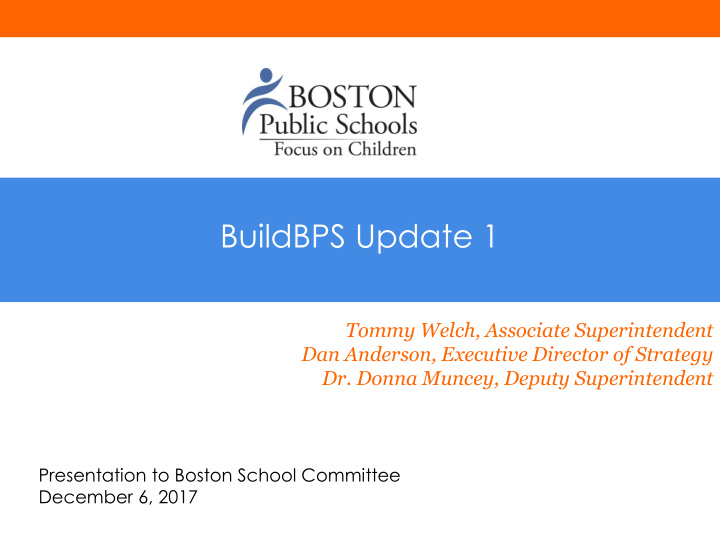



BuildBPS Update 1 Tommy Welch, Associate Superintendent Dan Anderson, Executive Director of Strategy Dr. Donna Muncey, Deputy Superintendent Presentation to Boston School Committee December 6, 2017
BOSTON PUBLIC SCHOOLS Grade Configurations Agenda ❏ Review of Theory of Action ❏ Overview of BuildBPS ❏ BuildBPS Project Categories ❏ Overview of Current Configurations ❏ Vision for the District ❏ Why Reconfigure? ❏ Considerations for K-6 / 7-12 ❏ Policy Proposal 2
BOSTON PUBLIC SCHOOLS Theory of Action 3
BOSTON PUBLIC SCHOOLS 4
BOSTON PUBLIC SCHOOLS 5
BOSTON PUBLIC SCHOOLS 20 Current Grade Configurations 6
BOSTON PUBLIC SCHOOLS We envision a district in which students make only one transition during their BPS journey We currently have 20 grade configurations… Focus on reconfigurations with current building stock …Over the next 5-10 years we will reduce our configurations... Build and renovate buildings to fit vision. … so that BPS has predominantly four grade configurations (K-6/7-12, K-8/9-12)
BOSTON PUBLIC SCHOOLS 1 Why Reconfigure? Decrease Transitions for Students -Research has shown that transitions can be detrimental to student achievement -In particular, research has shown that placement of middle grades (6-8) in stand- alone programs has a negative effect on student achievement -Reconfiguration would allow us to limit the number of planned transitions for students throughout their BPS education 8
BOSTON PUBLIC SCHOOLS 2 Why Reconfigure? Concentrating Resources for Students - Mixed configurations lead to uneven enrollments with some classes under capacity - Classes that are sufficiently enrolled generate enough funds to pay for more than a teacher - Classes that are below 87% enrolled do not generate enough funds to cover their costs - If we reconfigure to make sure all classes are full then all students can realize the benefits of the WSF (this is more financially sustainable model and concentrates resources more equitably for students) 9
BOSTON PUBLIC SCHOOLS 3 Why Reconfigure? Academic Programming - In order to run a full grade-level program in a middle school grade, a school requires a minimum of four sections in the grade level - This allows desireable programming and teacher collaboration time - With current enrollment patterns and the mix of grade configurations, it is challenging to maintain this concentration in middle and K-8 schools - Of BPS schools One current K-8 school has four sections of eighth - graders - 16 have two sections of eighth graders - 15 have one section of eighth graders 10
BOSTON PUBLIC SCHOOLS Why Reconfigure? 4 - a • Students often have widely varied paths through BPS that are Increase not always transparent when they begin Predictability for • Many families opt out of BPS in 4th-6th grade and reconfiguration for coherence could make the district a more Families attractive option to families • There are not enough schools to serve current BPS 5 elementary students close to home in Hyde Park, Mattapan, the southern half of Dorchester, Roslindale, or West Roxbury Capacity and demand is projected to increase • Yet we have over 1200 excess seats in grades 6-8 and are in second year of a forecasted 4 year decline in high school enrollment • Taken together: this means we have a mismatch of current school buildings and student geographic distribution • Reconfiguration can help alleviate this challenge by adjusting schools to meet the specific needs we have within the district 11
BOSTON PUBLIC SCHOOLS Considerations to increase # of K-6 / 7-12 Schools There are more opportunities to K-6 / 7-12 improves access to high convert to K-6 than to K-8 due to: quality middle school programming ● Building stock often not sizable ● In order to run a full grade-level enough for K-8 program in a middle grade, a ● We need more space at school requires a minimum of elementary level and have more four sections in the grade level excess space at the secondary ● K-6 / 7-12 allows us to use excess level to leverage, so K-6/7-12 capacity in high school facilities configurations provide potential and to create concentrated sixth- benefits sooner to more students eighth grade programs that can ● As we invest and make long-term sustain vibrant teaching and changes, we aim to establish 21st learning communities century learning environments, which needing more space (and therefore harder to do in a K-8)
BOSTON PUBLIC SCHOOLS Policy Proposal Boston Public Schools will become primarily a K-6/7- 12 and K-8/9-12 system, offering BPS students educational experiences that require only one transition for most students (while still offering them the choice a portfolio of various options). 13
BOSTON PUBLIC SCHOOLS Appendix: Selected Reconfiguration Research • Cook, P., R. MacCoun, C. Muschkin and J.L. Vigdor. (2011) “The Negative Impacts of Starting Middle School in Sixth Grade.” Journal of Policy Analysis and Management v. 27 n.1 (Winter 2008) pp.104-121. • Gordon, M. F. et al. (2011) Review of Literature of Grade Configuration and School Transitions. University of Minnesota, College of Education and Human Improvement: Center for Applied Research and Educational Improvement. • Schwerdt, G. and M. R. West (2011) The Impact of Alternative Grade Configurations on Student Outcomes through Middle and High School. Cambridge, Massachusetts: Program on Educational Policy and Governance, Harvard University. • West, M. R. and G. Schwerdt (2012) The Middle School Plunge. Achievement Tumbles When Young Students Change Schools. Education Next: 12(2). 14
Recommend
More recommend